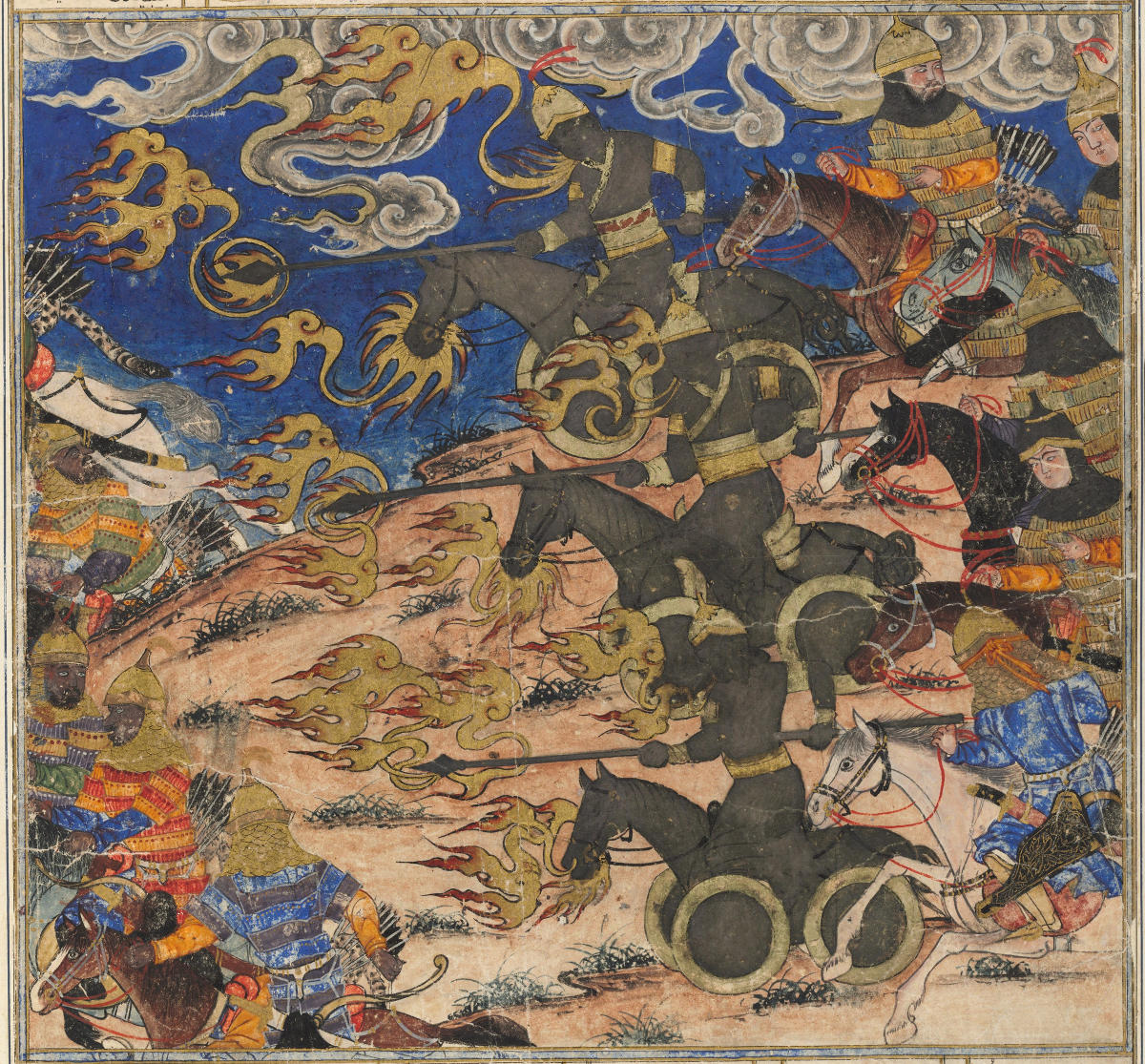Amazon Prime Student 6-month Trial

Amazon Audible Gift Memberships
Ilkhanid Illustration
Great Mongol (Demotte) Shahnama
Chapter 20 - Iskandar (14 years).
Iskandar builds iron cavalry to counter the massive Indian elephants
Battle between the armies of Iskandar and the Fur of Hind
Tabriz, Persia, c.1330-1340AD

A larger image of 'Battle between the armies of Iskandar and the Fur of Hind'. Great Mongol (Demotte) Shahnama.
Identification and Creation
Object Number: 1955.167
Title: Iskandar's Iron Cavalry Battles King Fur of Hind (text, recto; painting, verso), illustrated folio from the Great Ilkhanid Shahnama (Book of Kings)
Series/Book Title: Shahnama
Classification: Manuscripts
Work Type: manuscript folio
Date: c. 1330-1340
Creation Place: Middle East, Iran, Tabriz
Period: Ilkhanid period
Culture: Persian
Physical Descriptions
Medium: Ink, colors, gold, and silver on paper
Dimensions: folio: 50.2 x 39.5 cm (19 3/4 x 15 9/16 in.)
Acquisition and Rights
Credit Line: Harvard Art Museums/Arthur M. Sackler Museum, Gift of Edward W. Forbes
Accession Year: 1955
Source: Harvard Art Museums
48 Fig. 160
Iskandarís Iron Cavalry
Image: 27 x 29 cm (10⅝ x 11⅜ in.)
Harvard University Art Museums, Cambridge, Mass.,
Gift of Edward W. Forbes (1955.167)
Iskandar accepted King Kaydís offer of his four most prized possessions and left his lands unharmed.
He then proceeded to the kingdom of Fur (Porus) and invited him to surrender.
Fur refused, preferring to battle for supremacy.
After Iskandar was advised by his spies that his troops would be no match for the fearsome army of Indian elephants,
his sages designed a cavalry of iron riders and horses mounted on wheels, filled with naphtha and set aflame.
The Indian army, despite its strength, turned back in retreat before Iskandarís fire-spewing forces.
This painting is probably the most visually arresting of the manuscript.1
Its dynamic composition, together with its use of color and devices such as the swirling clouds in the sky,
which are echoed in the flames emitted by the iron horses, effectively captures the drama of the moment.
The truncated figures of the retreating Indian army create an illusion of space and underscore the impact of the illustration.
1. Grabar and Blair 1980, pp. 116-17, no. 30; Simpson 1980, pp. 26-27, no. 5; Hattstein and Delius 2000, p. 387.
Source: p.256, The Legacy of Genghis Khan Courtly Art and Culture in Western Asia 1256-1353
Cambridge, Harvard University Art Museums
Title of Work: Shahnama (Great Mongol)
Manuscript: 1919.130-1960.190
Accession Number: 1955.167
Chapter 20 - Iskandar (14 years)
Scene: Battle between the armies of Iskandar and the Fur
Dimensions (h x w): 270 x 290 mm
Format: Rectangular within borders
Reconstructed Folio: 167v
Gregorian Date: 1335 (circa)
School: Tabriz
Source: Shahnama Project
Previous: f. 165r: 'Kayd, the King of Hind, tells his dreams to his vizier, Mihran'. Great Mongol (Demotte) Shahnama. Tabriz, Persia. Ilkhanid Illustration. The Chester Beatty Library, Dublin, Per 111.5.
Next: f. 168r: 'Iskandar kills the Fur of Hind'. Great Mongol (Demotte) Shahnama. Tabriz, Persia. Ilkhanid Illustration. Keir Collection.
Back to the Great Mongol (Demotte) Shah-Nameh. Tabriz, Ilkhanid Persia.


